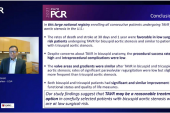Good Results For TAVI in Bicuspid Valves, but Questions Persist
Current THVs work in bicuspid anatomies, says one surgeon, but the real question is what happens over longer follow-up.

Two new analyses in low-risk patients suggest that clinical outcomes are as good in patients with congenital bicuspid anatomy undergoing transcatheter aortic valve implantation as it is in those with native tricuspid aortic valves.
Those studies, which were previously presented at TVT 2021 and are now published in JACC: Cardiovascular Interventions, show that the risk of all-cause mortality or disabling stroke with the Evolut R/PRO (Medtronic) valve, and the risk of all-cause mortality, stroke, and cardiovascular rehospitalization with the Sapien 3 (Edwards Lifesciences) device, was similar in patients with bicuspid and tricuspid aortic anatomy.
C. Michael Deeb, MD (University of Michigan, Ann Arbor), the lead investigator of the Evolut Low Risk Bicuspid Study, said the new analysis provides some reassurances for operators treating patients with bicuspid aortic valves, but emphasized that it’s still too early to know what the future holds.
“The real question is what is the true outcome? Is TAVR as good [as surgery]?” Deeb told TCTMD. “I don’t think this answers that question, but I think it answers an initial question,” that being whether TAVR devices work in this patient population. “We don’t need a new bicuspid valve. We can relieve the aortic stenosis just as well—our gradients are just as low, our effective orifice areas are just as big, our paravalvular leak is no different, and our procedural outcomes are the same.”
Coronary Access After Bicuspid TAVR
A third study, this one published in EuroIntervention, looks at the field from a different angle—namely, whether there is any difference between tricuspid and bicuspid valve disease when it comes to coronary access after TAVI. Fei Chen, MD (Sichuan University, Chengdu, China), and colleagues compared later coronary access in 86 patients with type 0 bicuspid aortic valves, 70 patients with type 1 bicuspid valves, and 132 patients with tricuspid aortic valves, all of whom underwent CT prior to the procedure as per guidelines.
Valve-related challenges to left and right coronary access—which was defined as a position where the coronary ostium faced the sealed commissural post or inner skirt of the transcatheter heart valve (THV)—was observed in 21.2% and 17.7% of all patients, respectively. However, the incidence of a THV position challenging coronary access was significantly lower in patients with a type 0 bicuspid valve. There was no difference in access challenges seen in patients with tricuspid valves and those with type 1 bicuspid valves.
If the coronary ostium faced the “tilted up” native leaflets, coronary engagement could also be challenging, according to the investigators. However, this was observed in only a small number of patients. Overall, the native leaflets interfered with left and right coronary access in 3.1% and 1.4% of cases, respectively, and there was difference seen in patients with different valve anatomies.
Thinking About The Future
To TCTMD, Deeb said they observed no apparent difficulties with coronary access after TAVI with Evolut R/PRO in patients with bicuspid aortic stenosis. Nonetheless, he emphasized that in a patient with bicuspid anatomy presenting with aortic stenosis, interventional cardiologists and surgeons must consider the lifetime management of the patient, and that includes thinking about the need for future coronary revascularization.
“If I have a 60-year-old person with a bicuspid valve and that’s it—bicuspid patients don’t have the same amount of coronary artery disease, renal disease, peripheral vascular disease, or carotid disease that tricuspid patients have—the likelihood that they’ll live to 80 is good,” said Deeb. “I have to think about how I’m going to get the patient to 80 years of age with the fewest number of procedures and the lowest cumulative risk.”
Interventional cardiologist Rodrigo Bagur, MD, PhD (London Health Sciences Centre/Western University, Canada), who wasn’t involved in any of the studies, noted there is no information regarding the implantation technique of operators in the Evolut analysis. However, the relatively high rate of pacemaker implantation—14.5% in bicuspid patients and 17.5% in those with tricuspid valves—indicates that a shallower implantation in the left ventricular outflow tract had not been employed. The depth of implantation and commissural alignment will ultimately make a large difference in being able to access the coronary arteries should future interventions be needed, he said.
“This is particularly important for a low-risk population who may develop significant coronary artery disease in the future,” said Bagur.
Low-risk patients with bicuspid anatomy are largely referred for cardiac surgery at his center, added Bagur. Like Deeb, he questioned whether the data truly indicate that TAVR is noninferior to surgery in patients with bicuspid anatomy.
No randomized trial has proven that TAVI is noninferior to surgery for bicuspid patients, Deeb stressed. “In tricuspid valves, we have solid data showing that it’s at least noninferior, and superior in high-risk patients, but in this particular subset we can’t tell them during the [heart team] discussion that it’s noninferior to surgery.”
Bagur emphasized the importance of collaboration with surgeons, noting that younger patients with bicuspid anatomy might be good candidates for a Ross procedure if the surgical team has experience with this type of surgery. “In our institution, we perform a fair number of Ross procedures because our surgeons are very good at it,” he told TCTMD. “As part of the heart team, it’s always nice to have broad experience in all fields, not just transcatheter technology, but with surgeons as well. The Ross procedure in a younger patient with a bicuspid valve should be on the table among the heart team discussion.”
FDA Missed an Opportunity
Although TAVI is approved in low-risk patients with bicuspid anatomy, that approval is based on relatively small prospective studies with limited follow-up in highly selected patients. There have been good reports from registry studies, but those observational data also have limitations. For that reason, researchers from both low-risk TAVI studies conducted propensity-matched analyses to determine how it stacked up in bicuspid patients compared with those with tricuspid aortic stenosis.
In the Evolut Low Risk Bicuspid Study, which included 150 patients with bicuspid anatomy propensity-matched to TAVI patients in the Evolut Low Risk Trial, all-cause mortality or disabling stroke at 1 year was 1.4% in the bicuspid arm and 2.8% in the tricuspid group (P = 0.413). In the PARTNER 3 bicuspid registry, which was led by Mathew Williams, MD (NYU Langone Medical Center, New York, NY), the primary endpoint of all-cause mortality, stroke, or cardiovascular rehospitalization was 10.9% in patients with a bicuspid aortic valve compared with 10.2% in those with a tricuspid valve (P = 0.80).
“At 1 year, these data are great, but what happens long term?” said Deeb. “What’s the durability? Do they last as long as in a tricuspid patient? What are you going to do with a younger patient population when they outgrow the valves? Are you going to subject them to additional procedures, and what are those additional procedures going to be?”
In an editorial, Ron Waksman, MD, and Giorgio Medranda, MD (both MedStar Washington Hospital Center, Washington, DC), say the two propensity-matched analyses are insufficient to answer the question of long-term durability. Moreover, despite the best efforts of investigators to match patients with bicuspid valves to those with tricuspid aortic valves, it’s impossible to do so completely. As a result, the TAVI data in bicuspid patients is “far from being definitive,” say the editorialists.
“In retrospect, an opportunity was missed when the FDA approved TAVR in patients with [bicuspid aortic valves] without requiring prospective randomized data for TAVR versus SAVR,” write Waksman and Medranda. “Regrettably, the impetus to fuel a randomized trial comparing TAVR with both THVs against SAVR in patients with [bicuspid aortic valves] has diminished significantly and would be challenging, as patients would be hesitant to enroll, and funding would be difficult to secure.”
Regarding the Evolut Low Risk Bicuspid Study analysis, Bagur noted that more than 90% of bicuspid patients had Sievers type 1 morphology. For this reason, he thinks it’s important to differentiate safety and efficacy of TAVI in the anatomic subtypes of bicuspid aortic stenosis. “Sievers type 1 is common, but anatomically speaking, the most cumbersome is Sievers type 0,” said Bagur. “We can’t generalize the concept to an unrepresented population.”
Michael O’Riordan is the Managing Editor for TCTMD. He completed his undergraduate degrees at Queen’s University in Kingston, ON, and…
Read Full BioSources
Deeb CM, Reardon MJ, Rambawi B, et al. Propensity-matched 1-year outcomes following transcatheter aortic valve replacement in low-risk bicuspid and tricuspid patients. J Am Coll Cardiol Intv. 2022;15:511-522.
Williams MR, Jilaihawi H, Makkar R, et al. The PARTNER 3 bicuspid registry for transcatheter aortic valve replacement in low-surgical-risk patients. J Am Coll Cardiol Intv. 2022;15:523-532.
Waksman R, Medranda GA. TAVR for low-risk bicuspid aortic stenosis: when in doubt, randomize. J Am Coll Cardiol Intv. 2022;15:533-535.
Disclosures
- Deeb reports serving on an advisory board for Medtronic, and receiving institutional grant support from Boston Scientific, Edwards Lifesciences, and Medtronic (he reports no personal renumeration).
- Williams reports consulting to Medtronic and receiving research funding from Edwards Lifesciences and Medtronic.
- Bagur reports no relevant conflicts of interest.
- Waksman reports serving on an advisory board for Abbott Vascular, Boston Scientific, Medtronic, Philips IGT, and Pi-Cardia; consulting for Abbott Vascular, Biotronik, Boston Scientific, Cordis, Medtronic, Philips IGT, Pi-Cardia, Swiss Interventional Systems/SIS Medical, Transmural Systems, and Venous MedTech; receiving grant support from AstraZeneca, Biotronik, Boston Scientific, Chiesi, Medtronic, and Philips IGT; and serving as part of the speakers bureau for AstraZeneca.





Comments